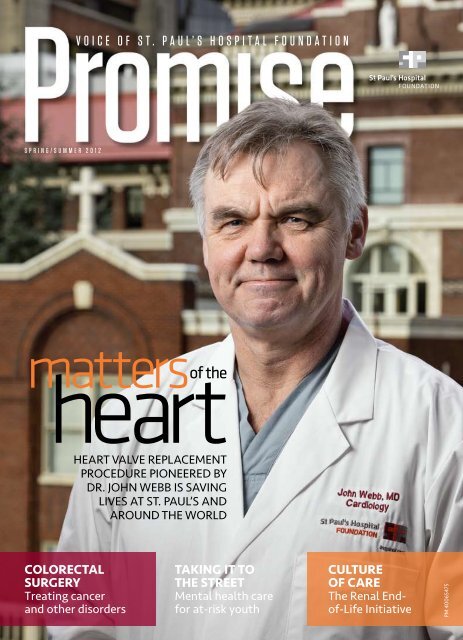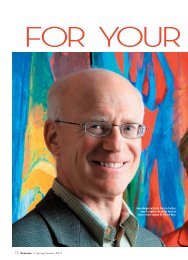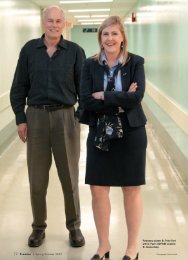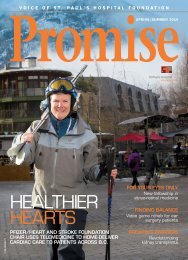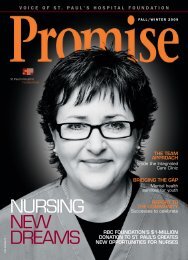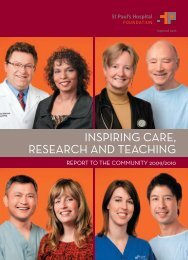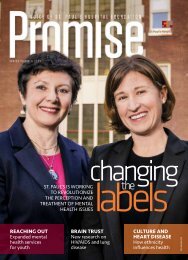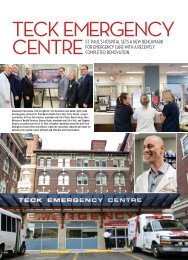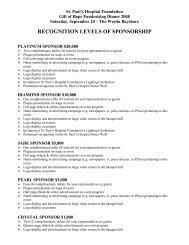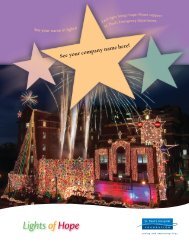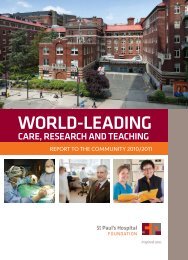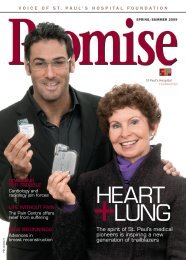Download the complete issue (1.7 MB PDF) - St. Paul's Hospital ...
Download the complete issue (1.7 MB PDF) - St. Paul's Hospital ...
Download the complete issue (1.7 MB PDF) - St. Paul's Hospital ...
You also want an ePaper? Increase the reach of your titles
YUMPU automatically turns print PDFs into web optimized ePapers that Google loves.
voice of st. Paul’s <strong>Hospital</strong> Foundation<br />
s p r i n g / s u m m e r 2 0 1 2<br />
matters<br />
heart<br />
of <strong>the</strong><br />
Heart valve replacement<br />
procedure pioneered by<br />
Dr. John Webb is saving<br />
lives at <strong>St</strong>. Paul’s and<br />
around <strong>the</strong> world<br />
Colorectal<br />
Surgery<br />
Treating cancer<br />
and o<strong>the</strong>r disorders<br />
Taking it to<br />
<strong>the</strong> <strong>St</strong>reet<br />
Mental health care<br />
for at-risk youth<br />
Culture<br />
of Care<br />
The Renal Endof-Life<br />
Initiative<br />
PM 40065475
from<strong>the</strong>top<br />
Forward Momentum<br />
As we enter spring and our new fiscal year,<br />
I am truly excited about <strong>the</strong> future of <strong>St</strong>. Paul’s<br />
<strong>Hospital</strong> Foundation. I would like to update<br />
you on a few important developments for<br />
<strong>St</strong>. Paul’s <strong>Hospital</strong>.<br />
First, a search committee has been working<br />
hard over <strong>the</strong> last few months to identify <strong>the</strong><br />
Foundation’s new president & CEO. I am pleased<br />
to let you know that <strong>the</strong> search process is<br />
proceeding well and on schedule and that we will<br />
soon be able to introduce you to this person.<br />
We are proud to highlight many of those<br />
recent successes in this <strong>issue</strong> of Promise. For<br />
example, our supporters played a critical role<br />
in helping us purchase a new $1-million vascular<br />
angiography system (page 4), which will support<br />
<strong>the</strong> well-being and lives of patients in acute-care<br />
programs throughout <strong>the</strong> hospital, and in <strong>the</strong><br />
success of our 2011 Lights of Hope campaign<br />
(page 5), which raised $2.27 million for our<br />
hospital’s greatest needs.<br />
This <strong>issue</strong>’s cover story features interventional<br />
cardiologist Dr. John Webb and <strong>the</strong> groundbreaking<br />
transca<strong>the</strong>ter aortic valve implantation (TAVI)<br />
procedure (page 8). TAVI is a life-saving solution<br />
for those unable to undergo open-heart surgery<br />
in B.C. and around <strong>the</strong> world – and this innovative<br />
procedure was pioneered here at <strong>St</strong>. Paul’s<br />
with <strong>the</strong> support of our donors.<br />
This <strong>issue</strong> also explores <strong>the</strong> critical role of<br />
laboratory services in <strong>the</strong> care of patients at<br />
<strong>St</strong>. Paul’s and around <strong>the</strong> province (page 7); our<br />
Department of Surgery’s excellence in treating<br />
colorectal cancer and o<strong>the</strong>r disorders of <strong>the</strong><br />
gastrointestinal tract (page 12); <strong>the</strong> Inner City<br />
Youth Mental Health Program’s expanding role<br />
in delivering psychiatric services to homeless<br />
teens (page 14); and <strong>the</strong> way our Renal End-of-<br />
Life initiative and Advance Care Planning<br />
program are creating a new culture of compassionate<br />
care for patients at <strong>St</strong>. Paul’s (page 15).<br />
On a personal note, my two-year term as<br />
Chair comes to an end this summer. I would like<br />
to thank everyone who has contributed to <strong>the</strong><br />
Foundation’s many accomplishments over <strong>the</strong><br />
past two years. I look forward to continuing to<br />
serve <strong>the</strong> hospital as a member of <strong>the</strong> Board of<br />
<strong>the</strong> Foundation for years to come.<br />
I would also like to take this opportunity to<br />
welcome our incoming Chair, David Poole.<br />
David is <strong>the</strong> Senior Vice-President, BC & Yukon,<br />
at Scotiabank. He is a passionate advocate for<br />
<strong>the</strong> Foundation and has served with our Board<br />
since 2008.<br />
I look forward to working with David, fellow<br />
board members, our new president and CEO,<br />
staff, and our many donors and partners in<br />
continuing to support world-leading patient<br />
care, research and teaching at our hospital.<br />
Thank you all.<br />
Henry F. Man<br />
Chair, <strong>St</strong>. Paul’s <strong>Hospital</strong> Foundation<br />
President & CEO, Magellen Developments (20/20) Inc.<br />
P.S. For <strong>the</strong> latest news about <strong>St</strong>. Paul’s <strong>Hospital</strong>, follow us!<br />
@helpstpauls<br />
facebook.com/helpstpauls<br />
2 Promise n Spring/Summer 2012 Photo: Brian Smith
Promıse<br />
spring/summer 2012<br />
VOLUME 10, NU<strong>MB</strong>ER 1<br />
EDITOR<br />
Ann Collette<br />
CONTRIBUTING EDITOR<br />
Brice Dare<br />
ART DIRECTOR<br />
Ren Reed<br />
Contributing Writers<br />
Helena Bryan, Brice Dare, Melissa Edwards,<br />
Nancy Gratham, Gail Johnson, J.K. Malmgren<br />
Contributing Photographers/<br />
Illustrators<br />
Sandra Lauck, IAS/Marcus Rose/Workers’<br />
Photos, RS Productions, Jay Shaw,<br />
Brian Smith – Providence Health Care<br />
Media Services<br />
senior IMAGING technician<br />
Debbie Lynn Craig<br />
ELECTRONIC IMAGING<br />
Bernhard Holzmann, Laura Michaels<br />
PRODUCTION manager<br />
Suzy Williamson<br />
studio manager<br />
Kristina Borys<br />
circulation<br />
Scott Wheatley, Tracy McRitchie,<br />
Ginger Jessamine<br />
4th Floor, 4180 Lougheed Highway<br />
Burnaby, B.C., V5C 6A7<br />
Phone: 604-299-7311 Fax: 604-299-9188<br />
chairman, ceo<br />
Peter Legge, O.B.C., LL.D. (Hon)<br />
PResident<br />
Karen Foss<br />
We welcome your comments on Promise magazine.<br />
Please write to us c/o <strong>St</strong>. Paul’s <strong>Hospital</strong> Foundation,<br />
178 –1081 Burrard <strong>St</strong>reet, Vancouver, B.C., V6Z 1Y6.<br />
Website: www.helpstpauls.com<br />
Phone: 604-682-8206; Fax: 604-806-8326.<br />
Promise magazine is published twice a year by<br />
Canada Wide Media Limited for <strong>St</strong>. Paul’s <strong>Hospital</strong><br />
Foundation. No part of this magazine may be reproduced<br />
without written permission of <strong>the</strong> publisher. Send changeof-address<br />
notices and covers of undeliverable copies to:<br />
Promise, c/o <strong>St</strong>. Paul’s <strong>Hospital</strong> Foundation,<br />
178 –1081 Burrard <strong>St</strong>reet, Vancouver, B.C., V6Z 1Y6.<br />
For subscription enquiries, call 604-682-8206.<br />
ISSN: 1703-6151. Canadian Publications Mail Product Sales<br />
Agreement No. 40065475.<br />
Photos: Brian Smith (cover), Brian Smith, RS<br />
PRODUCTIONS (biker), i<strong>St</strong>ock (hands)<br />
Cover<br />
8 Matters of <strong>the</strong> Heart<br />
Interventional cardiologist Dr. John<br />
Webb’s groundbreaking TAVI procedure<br />
may soon be <strong>the</strong> gold standard<br />
for aortic heart valve replacement.<br />
By Helena Bryan<br />
Features<br />
12 Colorectal Surgery<br />
to <strong>the</strong> Forefront<br />
<strong>St</strong>. Paul’s <strong>Hospital</strong> is a national leader<br />
in care, research and teaching to treat<br />
colorectal cancer and o<strong>the</strong>r gastrointestinal<br />
disorders.<br />
by Gail Johnson<br />
14 Taking It To<br />
The <strong>St</strong>reet<br />
<strong>St</strong>. Paul’s <strong>Hospital</strong>’s Inner City Youth<br />
Mental Health Program is helping<br />
homeless youth turn <strong>the</strong>ir lives around.<br />
By Melissa Edwards<br />
15 Shifting The Culture<br />
of Care<br />
The Renal End-of-Life initiative encourages<br />
physicians and staff to discuss<br />
future care with patients to improve<br />
quality of life.<br />
By J.K. Malmgren<br />
Departments<br />
2 From <strong>the</strong> Top<br />
Forward Momentum<br />
By Henry Man<br />
5 Frontlines<br />
Donors fund new vascular angiography<br />
system; 2011 Lights of Hope campaign<br />
inspires support; “Treatment as Prevention”<br />
earns global recognition; <strong>St</strong>. Paul’s<br />
<strong>Hospital</strong> in <strong>the</strong> News; Running for<br />
<strong>St</strong>. Paul’s <strong>Hospital</strong> at <strong>the</strong> Scotiabank<br />
Half Marathon & 5K Charity Challenge;<br />
<strong>St</strong>. Paul’s <strong>Hospital</strong>’s Heart Health Forum;<br />
Five great ways to give.<br />
7 Breakthroughs<br />
Department of Pathology and Laboratory<br />
Medicine impacts <strong>the</strong> care of patients<br />
throughout <strong>the</strong> hospital and region.<br />
inside<br />
108<br />
7<br />
12<br />
14<br />
15<br />
Spring/Summer 2012 n Promise 3
frontlines<br />
Dialysis patient<br />
William Katz is one<br />
of <strong>the</strong> people who<br />
will benefit from<br />
<strong>the</strong> new vascular<br />
angiography system.<br />
Donors Fund New Vascular Angiography System<br />
Beginning April 2012, patients will benefit<br />
from a new $1-million vascular angiography<br />
system purchased with <strong>the</strong> support<br />
of donors to <strong>St</strong>. Paul’s <strong>Hospital</strong> Foundation.<br />
“Thank you to everyone who helped<br />
bring this absolutely essential technology<br />
to <strong>St</strong>. Paul’s <strong>Hospital</strong>,” says Dr. Jonathon<br />
Leipsic, head of <strong>the</strong> Department of Radiology.<br />
“It will make an incredible difference in <strong>the</strong><br />
lives of thousands of patients who rely on<br />
<strong>the</strong> system to maintain <strong>the</strong>ir well-being.”<br />
The vascular angiography system,<br />
featured in <strong>the</strong> Spring/Summer 2011<br />
edition of Promise, supports patients in all<br />
acute-care programs (those that treat brief<br />
but severe episodes of illness) by helping to<br />
get images of <strong>the</strong> inside of patients’ blood<br />
vessels to diagnose problems such as<br />
blood clots, and <strong>the</strong>n correct <strong>the</strong>m with<br />
interventional procedures.<br />
More than 400 donors supported <strong>the</strong><br />
campaign to replace <strong>the</strong> existing vascular<br />
angiography system. The new system<br />
was ranked as <strong>the</strong> most critical major<br />
capital need at Providence Health Care,<br />
which operates <strong>St</strong>. Paul’s <strong>Hospital</strong> and<br />
14 o<strong>the</strong>r sites in Vancouver.<br />
“Treatment as Prevention” Earns Global Recognition<br />
Dr. Julio Montaner<br />
is director of <strong>the</strong><br />
BC Centre for Excellence<br />
in HIV/AIDS and UBC/<br />
<strong>St</strong>. Paul’s <strong>Hospital</strong><br />
Foundation Chair in AIDS.<br />
The made-in-B.C. “Treatment as<br />
Prevention” strategy continues to<br />
receive worldwide scientific recognition<br />
and political support, creating fur<strong>the</strong>r<br />
momentum to implement this proven<br />
breakthrough approach to combatting HIV<br />
and AIDS in Canada and around <strong>the</strong> world.<br />
The strategy was named breakthrough<br />
of 2011 by Science magazine and a medical<br />
breakthrough for 2012 by Readers Digest.<br />
It was also recognized as one of <strong>the</strong><br />
top-10 medical breakthroughs by Time<br />
magazine. In addition, U.S. President<br />
Barack Obama and Secretary of <strong>St</strong>ate<br />
Hillary Clinton both endorsed Treatment<br />
as Prevention as a cornerstone strategy to<br />
fight HIV and AIDS in <strong>the</strong> U.S. and around<br />
<strong>the</strong> world.<br />
Treatment as Prevention was pioneered<br />
by <strong>the</strong> BC Centre for Excellence in HIV/AIDS<br />
(BC-CfE) at <strong>St</strong>. Paul’s <strong>Hospital</strong>. The strategy<br />
involves widespread HIV testing and provision<br />
of anti-HIV drugs known as highly<br />
active antiretroviral <strong>the</strong>rapy (HAART) –<br />
<strong>the</strong> gold standard of HIV/AIDS treatment<br />
that <strong>the</strong> BC-CfE also helped to develop.<br />
For more information on how you can<br />
support care, research and teaching that<br />
benefits HIV/AIDS patients at <strong>St</strong>. Paul’s and<br />
beyond, please call 604-682-8206, or visit<br />
us online at www.helpstpauls.com.<br />
4 Promise n Spring/Summer 2012 Photos: Brian Smith, and ©IAS/Marcus Rose/Workers’ Photos (Montaner pic)
2011 Lights of Hope Inspire Support<br />
frontlines<br />
<strong>St</strong>. Paul’s <strong>Hospital</strong> shone during <strong>the</strong> 2011 Lights of Hope<br />
campaign thanks to <strong>the</strong> generosity of <strong>the</strong> community. This<br />
year, donors gave $2.27 million to <strong>the</strong> campaign to support<br />
<strong>the</strong> hospital’s greatest needs, surpassing <strong>the</strong> campaign goal<br />
of $1.9 million.<br />
Two contributors to <strong>the</strong> campaign’s success were John<br />
and Verna Wiens, who experienced <strong>the</strong> compassionate and<br />
world-leading care at <strong>St</strong>. Paul’s first-hand.<br />
John underwent a dual kidney and heart transplant in<br />
1999, but that operation almost never happened after he<br />
suffered a sudden and near-fatal cardiac arrest in <strong>the</strong> preceding<br />
weeks. While doctors and nurses at <strong>St</strong>. Paul’s were able to<br />
bring him back to life after working on him for 45 minutes,<br />
no one knew if John would recover enough to undergo <strong>the</strong><br />
transplant. Miraculously, five weeks later, John did receive<br />
a successful transplant – and his wife, Verna, saw <strong>the</strong><br />
effect immediately.<br />
“When he opened his eyes after <strong>the</strong> transplant, it was like<br />
<strong>the</strong> lights had been out and <strong>the</strong>n got switched back on,” Verna<br />
recalls. “I haven’t seen bright eyes in years. Anyone who visited<br />
him just stood back and said, ‘What a miracle!’”<br />
Their experiences inspired <strong>the</strong> couple and <strong>the</strong>ir company,<br />
Graestone Ready-Mix Inc., to support <strong>St</strong>. Paul’s <strong>Hospital</strong> and <strong>the</strong><br />
Lights of Hope for <strong>the</strong> last 12 years.<br />
“We enjoy giving to <strong>the</strong> Lights of Hope because it shows that<br />
<strong>the</strong>re is a host of support for <strong>the</strong> hospital,” John says “There are<br />
people who volunteer to set it up, which in itself is quite a feat.<br />
And <strong>the</strong>n all <strong>the</strong> different stars that represent <strong>the</strong> people and<br />
companies who are contributing because <strong>the</strong>y feel <strong>St</strong>. Paul’s is<br />
worthwhile. I think that’s just wonderful.”<br />
For more information on <strong>the</strong> annual Lights of Hope campaign<br />
or to learn more about John and Verna Wiens’ story, please call<br />
604-682-8206 or visit us online at www.lightsofhope.com.<br />
Lights of Hope (above) raised $2.27 million in 2011, thanks to many generous donors including longtime supporters John and Verna Wiens (top right).<br />
<strong>St</strong>. Paul’s <strong>Hospital</strong> in <strong>the</strong> News<br />
This spring, The Province newspaper is beginning a multi-part<br />
series on <strong>the</strong> difference <strong>St</strong>. Paul’s <strong>Hospital</strong> is making in <strong>the</strong> lives<br />
of patients from all over B.C. Each month, The Province dedicates<br />
an entire week of stories focused on getting to know patients,<br />
doctors, staff and researchers in different areas of <strong>the</strong> hospital<br />
– shedding light on <strong>the</strong> life-and-death decisions made every day<br />
at a hospital that provides care to 380,000 patients a year,<br />
including our most vulnerable and marginalized populations.<br />
For more information on The Province’s story series on<br />
<strong>St</strong>. Paul’s <strong>Hospital</strong>, call 604-682-8206 or visit us online at<br />
www.helpstpauls.com.<br />
Photos: Brian Smith<br />
Spring/Summer 2012 n Promise 5
frontlines<br />
Scotiabank Half Marathon& 5K Charity Challenge<br />
Run • Walk • Raise Funds for <strong>St</strong>. Paul’s<br />
On <strong>the</strong> Run for <strong>St</strong>. Paul’s <strong>Hospital</strong><br />
<strong>St</strong>. Paul’s <strong>Hospital</strong> Foundation is<br />
looking for people to run, walk and<br />
raise funds for <strong>St</strong>. Paul’s <strong>Hospital</strong> during<br />
<strong>the</strong> Scotiabank Vancouver Half-Marathon<br />
& 5K Charity Challenge on Sunday,<br />
June 24, 2012.<br />
Anyone is welcome to join <strong>the</strong> <strong>St</strong>.<br />
Paul’s <strong>Hospital</strong> Foundation team or create<br />
<strong>the</strong>ir own fundraising teams to support<br />
world-leading care, research and teaching<br />
at <strong>St</strong>. Paul’s. Remember, you can walk or<br />
run, and <strong>the</strong> 5K is a great alternative if<br />
you’re not quite up for <strong>the</strong> half-marathon!<br />
Registration is free for any participants<br />
who pledge to raise $100 or more for<br />
<strong>St</strong>. Paul’s <strong>Hospital</strong> Foundation.<br />
For more information on how you can step<br />
up and support <strong>St</strong>. Paul’s <strong>Hospital</strong> Foundation<br />
at <strong>the</strong> Scotiabank Group Charity Challenge,<br />
call 604-806-9849 or visit us online at<br />
www.helpstpauls.com.<br />
<strong>St</strong>. Paul’s <strong>Hospital</strong> Heart Health Forum<br />
Chelsie Thurlow with<br />
husband <strong>St</strong>ephan and<br />
daughter Chloe.<br />
More than 100 people ga<strong>the</strong>red at <strong>the</strong><br />
Scotiabank Theatre in Vancouver to learn<br />
how to get heart healthy during <strong>the</strong><br />
<strong>St</strong>. Paul’s <strong>Hospital</strong> Heart Health Forum<br />
held on February 29.<br />
Those in attendance had an opportunity<br />
to hear directly from experts at <strong>the</strong><br />
world-leading provincial Heart Centre<br />
at <strong>St</strong>. Paul’s <strong>Hospital</strong> and participate in a<br />
question-and-answer session with <strong>the</strong>m.<br />
They also heard <strong>the</strong> story of former<br />
patient Chelsie Thurlow,<br />
who suffered a cardiac<br />
arrest at <strong>the</strong> age of 23. After<br />
100 minutes of advanced<br />
cardiopulmonary resuscitation<br />
(CPR) followed by 10<br />
days on life-support and<br />
several surgeries, Thurlow’s<br />
life was saved.<br />
“It’s an honour to be<br />
here today to celebrate life<br />
and recognize <strong>the</strong> medical<br />
care I received at <strong>St</strong>. Paul’s<br />
<strong>Hospital</strong>; it was none o<strong>the</strong>r<br />
than extraordinary,” says Thurlow. “There<br />
was never a moment of doubt that <strong>the</strong>y<br />
weren’t doing everything in <strong>the</strong>ir power<br />
to ensure <strong>the</strong> best outcome for me.” n<br />
For more information on how you can<br />
support care, research and teaching that<br />
benefits <strong>the</strong> heart health of patients at<br />
<strong>St</strong>. Paul’s, or to learn more about Chelsie<br />
Thurlow’s story, please call 604-682-8206<br />
or visit us online at www.helpstpauls.com.<br />
5great gıve<br />
WAYS TO<br />
1. Become a monthy donor<br />
Automatic payments from your<br />
credit card or bank account are<br />
convenient and save you <strong>the</strong> time<br />
and money it takes to mail in<br />
donations. At <strong>the</strong> end of <strong>the</strong> year,<br />
you’ll be surprised by how your<br />
contributions and tax credits have<br />
added up, while providing a stable<br />
and reliable source of funding for<br />
<strong>St</strong>. Paul’s. Call 604-806-8912.<br />
2. Give a gift of securities<br />
Save a significant amount of money<br />
at tax time by donating securities,<br />
such as publicly traded shares and<br />
mutual funds, even if you have a<br />
capital loss! Call 604-806-8923.<br />
3. Honour a loved one<br />
A gift made in honour of a family<br />
member or friend can be a special<br />
and unique way to pay tribute to<br />
<strong>the</strong>m or <strong>the</strong>ir memory, or to<br />
celebrate a milestone occasion<br />
such as a birthday or wedding.<br />
Call 604-806-8912.<br />
4. Make a bequest or a planned gift<br />
Plan for a future gift ei<strong>the</strong>r in your<br />
will or through ano<strong>the</strong>r means such<br />
as life insurance, an RRSP or RRIF, or<br />
a trust. Call 604-806-8271.<br />
5. Contact Us<br />
Mail: 178-1081 Burrard <strong>St</strong>.,<br />
Vancouver, B.C. V6Z 1Y6<br />
Phone: 604-682-8206<br />
E-mail: sphfoundation@<br />
providencehealth.bc.ca<br />
Web: www.helpstpauls.com<br />
6 Promise n Spring/Summer 2012 Photo: Jay Shaw
y Nancy Gratham<br />
breakthroughs<br />
Instrumental to Care<br />
Innovative technology – and <strong>the</strong> pathologists and technologists who use it – play a<br />
crucial role in patient care at <strong>St</strong>. Paul’s <strong>Hospital</strong> and health-care facilities throughout B.C.<br />
Behind <strong>the</strong> scenes at <strong>St</strong>. Paul’s <strong>Hospital</strong>,<br />
beyond <strong>the</strong> doors of <strong>the</strong> Teck<br />
Emergency Centre, is a specialized<br />
department that has a vital impact<br />
on <strong>the</strong> care of patients throughout <strong>the</strong> hospital<br />
and region – <strong>the</strong> Department of Pathology<br />
and Laboratory Medicine.<br />
Dr. Enid Edwards, medical director of<br />
<strong>the</strong> laboratory, says that close to 75 per cent<br />
of <strong>the</strong> decisions made at <strong>St</strong>. Paul’s <strong>Hospital</strong><br />
on any given day will be based on <strong>the</strong> results<br />
of tests painstakingly performed in <strong>the</strong> lab.<br />
“Our tentacles are everywhere,” she laughs.<br />
<strong>St</strong>. Paul’s <strong>Hospital</strong>’s lab is potentially<br />
involved in <strong>the</strong> care of each and every patient<br />
at <strong>St</strong>. Paul’s, providing basic blood work<br />
for 73,000 emergency patients and o<strong>the</strong>r<br />
admitted patients per year, specialty lipid<br />
tests for cardiac patients, helper-suppressor<br />
ratios for people with HIV, and o<strong>the</strong>r, more<br />
complicated tests for a variety of patients.<br />
The department’s team of 28 highly-trained<br />
pathologists and 200 technical staff relish<br />
<strong>the</strong> task.<br />
“We’re instrumental in responding to <strong>the</strong><br />
needs of many,” explains Edwards – including<br />
patients from Vancouver and across <strong>the</strong><br />
province. <strong>St</strong>. Paul’s is <strong>the</strong> sole provider in <strong>the</strong><br />
region and/or province for specialized laboratory<br />
tests such as certain endocrine tests<br />
and viral tests for HIV patients, as well as for<br />
interpreting kidney biopsies for patients living<br />
on mainland B.C. That means <strong>the</strong> work of<br />
<strong>the</strong>se pathologists and technologists doesn’t<br />
just play a critical role in supporting <strong>St</strong>. Paul’s<br />
provincial programs in areas such as heart,<br />
HIV/AIDS and kidney; <strong>the</strong>y also play a significant<br />
role in supporting <strong>the</strong> care of patients<br />
at o<strong>the</strong>r health-care facilities.<br />
According to Michael Aeberhardt, operations<br />
director of laboratory services for<br />
Providence Health Care, activity in <strong>the</strong> lab is<br />
consistently increasing by five to 10 per cent<br />
each year. Despite that added workload,<br />
he says <strong>the</strong> department continues its “relentless<br />
pursuit of perfection and to shorten turnaround<br />
times.”<br />
Microbiology technologist <strong>St</strong>acey Solomon (left) and Dr. Marc Romney load samples into a newly<br />
acquired blood culture analyzer.<br />
Technological advances<br />
Amid <strong>the</strong> test tubes and glass slides in <strong>the</strong><br />
microbiology division of <strong>the</strong> lab sits a big<br />
black blood culture analyzer – a newly<br />
acquired point of pride among those who<br />
work here.<br />
“We love it,” says Dr. Marc Romney, a<br />
medical microbiologist and medical director<br />
for Infection Prevention and Control (IPAC)<br />
for Providence Health Care, which operates<br />
<strong>St</strong>. Paul’s <strong>Hospital</strong>. “It’s a great machine.”<br />
Purchased through <strong>the</strong> support of donors<br />
to <strong>St</strong>. Paul’s <strong>Hospital</strong> Foundation, <strong>the</strong> analyzer<br />
allows <strong>the</strong> lab to diagnose patients with<br />
bloodstream infections and sepsis, one of <strong>the</strong><br />
most severe forms of infection.<br />
It also allows <strong>the</strong> Department to recover<br />
bacteria from patients’ blood rapidly and<br />
accurately. The laboratory makes <strong>the</strong><br />
diagnosis so <strong>the</strong> most appropriate<br />
antibiotics can be prescribed.<br />
In a department that is expected<br />
to be at <strong>the</strong> forefront of technology,<br />
gifts like <strong>the</strong> blood culture analyzer<br />
are so appreciated, whe<strong>the</strong>r <strong>the</strong> new<br />
equipment is a replacement part to keep <strong>the</strong><br />
lab running or something new to move it into<br />
<strong>the</strong> next era of testing, like <strong>the</strong> powerful<br />
MALDI-TOF mass spectrometer.<br />
“It allows us to identify bacteria in a<br />
matter of minutes instead of days,” says<br />
Romney. That means better care, which is<br />
ultimately <strong>the</strong> end goal for <strong>the</strong>se pathologists<br />
and technologists who serve <strong>the</strong> patients<br />
at <strong>St</strong>. Paul’s and across <strong>the</strong> province. n<br />
For more information on how you can<br />
support <strong>the</strong> needs of <strong>the</strong> <strong>St</strong>. Paul’s <strong>Hospital</strong><br />
Laboratory, please call 604-682-8206 or<br />
visit us online at www.helpstpauls.com.<br />
Photos: Brian Smith Spring/Summer 2012 n Promise 7
matters<br />
of <strong>the</strong> heart<br />
8 Promise n Spring/Summer 2012
Dr. John Webb’s groundbreaking<br />
TAVI procedure, which has<br />
resulted in <strong>the</strong> largest reduction<br />
in mortality of any heart <strong>the</strong>rapy,<br />
could make open-heart surgery<br />
a thing of <strong>the</strong> past.<br />
by Helena Bryan<br />
On a damp day in <strong>the</strong> spring of 2010, May Brown, 91<br />
at <strong>the</strong> time and with no history of heart trouble,<br />
was told her aortic valve was failing. She was<br />
also told that without intervention, <strong>the</strong> condition<br />
might eventually kill her.<br />
The former Vancouver city councillor and Order of<br />
Canada honoree learned that open-heart surgery would be<br />
too risky because of <strong>the</strong> scar t<strong>issue</strong> left behind after intense<br />
radiation treatments two decades earlier to treat esophageal<br />
cancer.<br />
However, not all <strong>the</strong> news was bad that day. The former<br />
physical education teacher and avid hiker and skier learned<br />
she fit <strong>the</strong> criteria for an innovative, minimally invasive<br />
procedure known as transca<strong>the</strong>ter aortic valve implantation<br />
(TAVI), which was pioneered by <strong>St</strong>. Paul’s <strong>Hospital</strong><br />
interventional cardiologist Dr. John Webb and his team.<br />
The technique was available on a limited basis to<br />
patients like Brown – people with significant valve problems<br />
who simply couldn’t tolerate open-heart surgery.<br />
Unlike open-heart surgery, <strong>the</strong> TAVI procedure wouldn’t<br />
require opening up her chest, sawing through her breastbone<br />
or putting her on a heart-lung machine. Instead,<br />
through a tiny incision at <strong>the</strong> top of her leg, surgeons could<br />
insert a collapsible valve on a ca<strong>the</strong>ter, guiding it to her<br />
heart through her circulatory system. However, she would<br />
have to wait her turn for it, and so she waited.<br />
Happily, on October 29, 2010, Brown got her turn and<br />
was brought to <strong>St</strong>. Paul’s for <strong>the</strong> life-saving procedure.<br />
(Main picture) Dr. John Webb, director of interventional<br />
cardiology and McLeod Family Professor in Valvular Heart<br />
Disease Intervention at <strong>St</strong>. Paul’s (right) performs his<br />
transca<strong>the</strong>ter aortic valve replacement procedure on a<br />
patient; (above inset) members of <strong>the</strong> TAVI team meet<br />
to discuss cases; (below inset) Webb uses <strong>the</strong> Edwards<br />
SAPIEN transca<strong>the</strong>ter heart valve in <strong>the</strong> procedure.<br />
Photos: Brian Smith, Sandra Lauck (above inset)<br />
Dramatic impact<br />
Brown says <strong>the</strong> wait for TAVI surgery proved to be well<br />
worth it. She was on her feet within 24 hours of receiving<br />
her new heart valve and back home within five days, feeling<br />
like a new person. In less than a week, she was ready to<br />
start walking again. Today, at 92, Brown says, “I feel great!<br />
I’m in good shape and everything looks really good.”<br />
Spring/Summer 2012 n Promise 9
The outcome for Brown likely wouldn’t<br />
have been as joyful if not for <strong>the</strong> groundbreaking<br />
efforts of Webb and his colleagues<br />
at <strong>St</strong>. Paul’s <strong>Hospital</strong>. As director of interventional<br />
cardiology and McLeod Family<br />
Professor in Valvular Heart Disease Intervention<br />
at <strong>St</strong>. Paul’s, Webb has led <strong>the</strong> efforts<br />
of a team of researchers and cardiac specialists<br />
in <strong>the</strong> development of TAVI – an effort<br />
Webb says was made possible by <strong>the</strong><br />
cooperative environment fostered at <strong>St</strong>. Paul’s<br />
and by funding from generous donors.<br />
Webb is not at all surprised by Brown’s<br />
recovery and cites a 2010 New England<br />
Journal of Medicine article that found that<br />
“<strong>the</strong>re are 20-per-cent more deaths in<br />
patients with severe aortic valve disease after<br />
one year who don’t undergo this surgery<br />
than in those who do – <strong>the</strong> largest reduction<br />
of mortality of any heart <strong>the</strong>rapy ever.”<br />
Put ano<strong>the</strong>r way, <strong>the</strong> success rate among<br />
high-risk patients who undergo TAVI is more<br />
than 95 per cent.<br />
With <strong>the</strong> evidence on his side, Webb is<br />
determined to make sure many more patients<br />
at <strong>St</strong>. Paul’s and around <strong>the</strong> world experience<br />
happy endings like Brown’s. In fact, he’d like<br />
to see TAVI someday replace open-heart surgery<br />
as <strong>the</strong> gold-standard procedure for aortic<br />
valve replacement. He’s willing, literally, to go<br />
to <strong>the</strong> ends of <strong>the</strong> earth to make that happen.<br />
Sharing <strong>the</strong> knowledge<br />
Since developing <strong>the</strong> first routinely successful<br />
percutaneous valve replacement technique<br />
in 2005, more than 500 successful surgeries<br />
have been performed at <strong>St</strong>. Paul’s <strong>Hospital</strong>,<br />
making it a leader in <strong>the</strong> field.<br />
In addition, Webb has worked tirelessly to<br />
share his knowledge and teach <strong>the</strong> procedure<br />
so that o<strong>the</strong>r surgeons can perform it with<br />
equal success. Webb travels extensively to<br />
speak at interventional cardiology symposia<br />
and teach <strong>the</strong> procedure. He and his team also<br />
run three-day courses at <strong>St</strong>. Paul’s <strong>Hospital</strong> at<br />
least once a month to teach <strong>the</strong> technique to<br />
up to 20 cardiologists from around <strong>the</strong> globe.<br />
Typically, <strong>the</strong> course includes one day of<br />
lectures and two days of procedures done in<br />
a simulated environment. It also includes<br />
follow-up. When graduates of <strong>the</strong> course<br />
first start doing <strong>the</strong> procedure in <strong>the</strong>ir home<br />
countries, Webb and his team actually travel<br />
to <strong>the</strong>m and assist with <strong>the</strong>ir initial cases.<br />
Webb’s travel itinerary over <strong>the</strong> past five years<br />
alone has included Turkey, Saudi Arabia,<br />
Japan, Australia, New Zealand and, most<br />
recently, China.<br />
In Shanghai, Webb and his team experienced<br />
some interesting hurdles in <strong>the</strong>ir path<br />
to assisting with <strong>the</strong> very first TAVI procedure<br />
in China. The valves Webb uses in his procedure<br />
are made from bovine t<strong>issue</strong>, but China<br />
had implemented beef import restrictions in<br />
response to <strong>the</strong> threat of Mad Cow disease.<br />
As a result, Webb and his team arrived at <strong>the</strong>ir<br />
teaching destination – a military hospital in<br />
Shanghai – minus <strong>the</strong> all-important valves.<br />
The Chinese surgeon, a general in <strong>the</strong><br />
army and head of <strong>the</strong> hospital, didn’t skip a<br />
beat. Explaining to his western colleagues<br />
Dr. John Webb (here and<br />
opposite) teaches <strong>the</strong> TAVI<br />
procedure to health care<br />
professionals around <strong>the</strong> world.<br />
that nobody would dare interfere with an<br />
army vehicle, he immediately dispatched a<br />
military limo to <strong>the</strong> airport to pick up and<br />
transport back <strong>the</strong> “contraband” valves.<br />
Since <strong>the</strong>n, <strong>the</strong> team has helped with ano<strong>the</strong>r<br />
procedure in China, with more to come.<br />
All told, Webb has taught <strong>the</strong> technique<br />
to colleagues in more than 25 countries, who<br />
have gone on to perform a total of 50,000<br />
aortic valve replacements using his method.<br />
In Canada, more than 10 hospitals are now<br />
doing <strong>the</strong> procedure.<br />
The efforts of Webb and his team have<br />
dramatically raised <strong>St</strong>. Paul’s profile in <strong>the</strong><br />
national and international health-care com-<br />
10 Promise n Spring/Summer 2012
munity, making <strong>the</strong> city a favoured destination<br />
for conferences and <strong>St</strong>. Paul’s a favoured<br />
destination for world-leading health-care<br />
professionals, fur<strong>the</strong>r enhancing care for<br />
patients here.<br />
Virtual lab expands<br />
teaching program<br />
Last year’s launch of <strong>St</strong>. Paul’s <strong>Hospital</strong>’s<br />
Virtual Teaching Laboratory has enabled<br />
Webb to expand his educational reach without<br />
having to leave <strong>the</strong> hospital. The Virtual<br />
Teach Laboratory, operated by <strong>the</strong> Media<br />
Services and Telemedicine Department at<br />
<strong>St</strong>. Paul’s, provides live feeds of procedures<br />
at <strong>St</strong>. Paul’s to lecture <strong>the</strong>atres at <strong>the</strong> hospital<br />
and around <strong>the</strong> world.<br />
One of those live feeds enabled 1,000<br />
attendees to watch Webb perform an<br />
actual valve replacement at <strong>the</strong> Canadian<br />
Cardiovascular Congress (CCC), a major<br />
cardiovascular medicine learning event<br />
held in Vancouver in October 2011. A fur<strong>the</strong>r<br />
850 saw Webb and his team in action at<br />
<strong>the</strong> Transca<strong>the</strong>ter Valve Therapy conference<br />
in Vancouver. And this is just <strong>the</strong> beginning.<br />
The new lab allows Webb to “virtually”<br />
go wherever cardiologists and cardiac surgeons<br />
ga<strong>the</strong>r.<br />
You also need <strong>the</strong> right tools to complement<br />
<strong>the</strong> expertise. In that vein, <strong>the</strong> Edwards<br />
SAPIEN transca<strong>the</strong>ter heart valve frequently<br />
used in <strong>the</strong> procedure received Health Canada<br />
approval in June, and FDA approval is on<br />
<strong>the</strong> horizon. As a result, Webb expects <strong>the</strong><br />
number of U.S. centres offering <strong>the</strong> procedure<br />
to go from five to 300 by <strong>the</strong> end of 2012.<br />
Here in Canada, however, even with<br />
Health Canada approval of <strong>the</strong> valve and<br />
TAVI’s remarkable success rate, <strong>the</strong> procedure<br />
is available only to those patients<br />
who are not good candidates for openheart<br />
surgery.<br />
At <strong>issue</strong> is <strong>the</strong> cost of <strong>the</strong> transca<strong>the</strong>ter<br />
valve, which is more expensive than a standard<br />
surgical valve. TAVI’s higher valve cost<br />
balances out for high-risk patients, once you<br />
consider how much longer <strong>the</strong>ir hospital<br />
stays would be with open-heart surgery. But<br />
for those who aren’t considered high-risk,<br />
open-heart surgery – an invasive procedure<br />
in which <strong>the</strong> heart is exposed and temporarily<br />
stopped to allow surgeons to suture a replacement<br />
valve in place – is currently <strong>the</strong> only<br />
option. However, Webb wants to change<br />
that, and he knows just where to start.<br />
New horizons<br />
Part of Webb’s vision for <strong>the</strong> future is <strong>the</strong><br />
creation of a specialized research and teaching<br />
facility at <strong>St</strong>. Paul’s <strong>Hospital</strong> called <strong>the</strong><br />
Canadian Valvular Innovation Centre, with<br />
sophisticated equipment, specialized operating<br />
rooms and comprehensive tracking,<br />
evaluation and screening programs.<br />
Here, Webb and his team could take <strong>the</strong>ir<br />
work, which has already earned <strong>St</strong>. Paul’s a<br />
reputation as a world leader in cardiac sciences,<br />
to <strong>the</strong> next level. With such a centre<br />
in place, staff would have <strong>the</strong> capacity to<br />
explore all <strong>the</strong> possibilities for less invasive<br />
cardiac procedures, starting with expanding<br />
<strong>the</strong> applications of TAVI to include <strong>the</strong><br />
replacement of pulmonary valves and artificial<br />
aortic valves that have failed after openheart<br />
surgery. Researchers could also investigate<br />
<strong>the</strong> use of less-expensive valves so<br />
that cost is no longer an <strong>issue</strong>.<br />
“We can show right now that this procedure<br />
is cheaper in high-risk patients,” says<br />
Webb. “We just have to come up with ways<br />
to fur<strong>the</strong>r decrease <strong>the</strong> costs so that more<br />
patients – not just those who can’t have surgery<br />
– can benefit from a technique that is<br />
just plain better than <strong>the</strong> alternative.” n<br />
For more information on how you can support<br />
care, research and teaching that benefits<br />
<strong>the</strong> heart health of patients at <strong>St</strong>. Paul’s<br />
and beyond, please call 604-682-8206 or<br />
visit us online at www.helpstpauls.com.<br />
TAVI by <strong>the</strong> numbers<br />
Interventional cardiologist Dr. John Webb performed <strong>the</strong> first successful transca<strong>the</strong>ter aortic valve implantation (TAVI) at<br />
<strong>St</strong>. Paul’s <strong>Hospital</strong> in 2005, putting <strong>St</strong>. Paul’s on <strong>the</strong> map as a leading centre for cardiac science. He hasn’t looked back since:<br />
25 and up .............. The number of countries in which transca<strong>the</strong>ter aortic valve implantation is now performed<br />
50,000 .................. The number of aortic valve replacements done worldwide since 2005<br />
More than 500 ..... The number of successful TAVI procedures done at <strong>St</strong>. Paul’s <strong>Hospital</strong> alone<br />
95% ....................... The success rate of TAVI among high-risk patients<br />
10 to 15 .................. The number of years a new biological valve is expected to last. l<br />
Photos: Brian Smith Spring/Summer 2012 n Promise 11
Colorectal Surgery<br />
to <strong>the</strong> Forefront<br />
<strong>St</strong>. Paul’s <strong>Hospital</strong> is a<br />
national leader in care,<br />
research and teaching<br />
to treat Canada’s seconddeadliest<br />
cancer and o<strong>the</strong>r<br />
disorders of <strong>the</strong> gastrointestinal<br />
tract.<br />
by Gail Johnson<br />
Tim Roddick (here) is back to doing all<br />
<strong>the</strong> things he loves following successful<br />
colorectal surgery at <strong>St</strong>. Paul’s <strong>Hospital</strong>;<br />
(opposite - left to right) Dr. Carl Brown,<br />
Dr. Terry Phang and Dr. Manoj Raval are<br />
working to create a centre for excellence<br />
in colorectal surgery at <strong>St</strong>. Paul’s.<br />
As an entrepreneur, husband<br />
and fa<strong>the</strong>r of a six-year-old, Tim<br />
Roddick has long been used to<br />
managing a hectic schedule.<br />
But a few years ago, some unusual symptoms<br />
became too troubling for <strong>the</strong> Vancouver<br />
resident to put aside.<br />
At first, his doctor told him that <strong>the</strong> blood<br />
in his stool was merely <strong>the</strong> result of hemorrhoids.<br />
But <strong>the</strong>n, he started experiencing<br />
fevers. His symptoms persisted for more<br />
than a year, at which point Roddick discovered<br />
that what he had was in fact far more<br />
serious. In May 2008, Roddick was diagnosed<br />
with a rare form of colorectal cancer.<br />
“It was a bit of a shock,” recalls Roddick,<br />
co-founder of MSR Innovations, a company<br />
that makes solar roofing systems. “It changed<br />
things a lot.”<br />
Roddick was referred to Dr. Terry Phang<br />
of <strong>St</strong>. Paul’s <strong>Hospital</strong>’s colorectal surgery<br />
program – which Roddick quickly discovered<br />
was one of <strong>the</strong> best in Canada for treating<br />
his illness.<br />
Centre for excellence in<br />
colorectal surgery<br />
<strong>St</strong>. Paul’s <strong>Hospital</strong> is home to three of B.C.’s<br />
eight subspecialty-trained colorectal surgeons<br />
– Drs. Phang, Carl Brown and Manoj<br />
Raval. Their expertise has resulted in <strong>the</strong><br />
development of a centre for excellence in<br />
colorectal surgery, with a focus on colorectal<br />
cancer, inflammatory bowel disease, and o<strong>the</strong>r<br />
diseases of <strong>the</strong> lower gastrointestinal tract.<br />
Thanks to this concentration of colorectal<br />
surgeons and <strong>the</strong>ir active involvement in<br />
research, <strong>the</strong> hospital is able to offer patients<br />
access to many innovative procedures,<br />
including minimally invasive, incision-sparing<br />
surgical techniques.<br />
For Roddick, things moved very quickly<br />
after meeting Phang. He had surgery to<br />
remove a tumour before going on to have<br />
radiation plus several sessions of interferon<br />
injections. For nearly a year he had a stoma,<br />
a surgically created opening in <strong>the</strong> abdominal<br />
wall to eliminate waste, until Phang<br />
performed ano<strong>the</strong>r surgery to reconnect his<br />
gastrointestinal tract.<br />
Although <strong>the</strong> diagnosis initially devastated<br />
Roddick and his family, he has enjoyed<br />
a remarkable recovery. “I do just about<br />
everything I used to do: I ski, swim, ride my<br />
dirt bike, and even got back into a race car.<br />
Dr. Phang and his staff have been brilliant.<br />
He’s absolutely dedicated to what he’s doing,<br />
he’s very skilled, and he’s determined – you<br />
can’t beat a combination like that.”<br />
Province-wide impact<br />
A unique provincial resource, <strong>St</strong>. Paul’s <strong>Hospital</strong>’s<br />
colorectal surgery program provides<br />
comprehensive care, including colorectal<br />
cancer screening and prevention, sophisticated<br />
diagnostic techniques (such as endoscopic<br />
tests involving flexible tubes with a<br />
small camera on <strong>the</strong> end), and a full spectrum<br />
12 Promise n Spring/Summer 2012<br />
Photos: RS PRODUCTIONS (Tim Roddick), Brian Smith
of treatment options, including laparoscopic<br />
surgery (minimally invasive procedures<br />
performed through small incisions).<br />
The program treats approximately 25<br />
per cent of all rectal cancer cases in B.C.,<br />
with about 30 per cent of patients coming<br />
from outside Metro Vancouver. Every week,<br />
Phang, Brown and Raval provide treatment<br />
to approximately 20 newly diagnosed<br />
cancer patients and follow-up care to ano<strong>the</strong>r<br />
50 patients.<br />
Phang notes that <strong>the</strong> <strong>St</strong>. Paul’s <strong>Hospital</strong><br />
team, in collaboration with <strong>the</strong> B.C. Cancer<br />
Agency, has improved cancer outcomes province-wide<br />
by offering educational programs<br />
to surgeons throughout B.C.: “We’re <strong>the</strong> only<br />
province that has done this. We’re continuing<br />
to lead improvement in colorectal cancer care<br />
and are always asking what we can do better.”<br />
Innovative care, research<br />
and teaching<br />
<strong>St</strong>. Paul’s <strong>Hospital</strong> is a leader in transanal<br />
endoscopic microsurgery (TEM), a minimally<br />
invasive procedure used to remove certain<br />
rectal polyps and tumours. TEM can be performed<br />
as a short-stay procedure, sometimes<br />
without general anes<strong>the</strong>tic, meaning most<br />
patients can go home <strong>the</strong> same day. The<br />
advanced technique spares patients <strong>the</strong><br />
significant risks and side-effects of major<br />
surgery, and <strong>the</strong>ir recovery is faster as well.<br />
“Having colorectal surgery is a lifechanging<br />
event, but TEM minimizes pain<br />
and <strong>the</strong> duration of a hospital stay with no<br />
abdominal incision at all,” says Brown.<br />
As a teaching hospital, <strong>St</strong>. Paul’s <strong>Hospital</strong><br />
is a training centre for gastroenterologists<br />
and general surgeons and advanced <strong>the</strong>rapeutic<br />
endoscopy fellows.<br />
“We’re now seeing residents we’ve<br />
trained out in practice,” says Raval. “We’re<br />
quite proud that we’ve had a role in training<br />
future surgeons. By giving <strong>the</strong>m a good,<br />
intensive experience we feel very confident<br />
that <strong>the</strong>y’ll go out and practise colorectal<br />
surgery throughout B.C., and part of our goal<br />
is improving care province-wide.”<br />
Phang, Brown and Raval all participate in<br />
research programs (including national randomized<br />
control trials) to improve outcomes and<br />
survival rates in patients with colorectal cancer<br />
and inflammatory bowel disease. All three are<br />
members of <strong>the</strong> B.C. Cancer Agency’s Surgical<br />
Oncology Network as well as its Colorectal<br />
Surgical Tumour Group, which Raval<br />
chairs. Brown chairs <strong>the</strong> agency’s Research<br />
Outcomes and Evaluation Committee.<br />
The doctors are quick to point out that<br />
many of <strong>the</strong> world-leading procedures and<br />
treatments now available at <strong>St</strong>. Paul’s <strong>Hospital</strong><br />
didn’t exist a decade ago, and require highly<br />
sophisticated, specialized and often expensive<br />
technology. Thanks to <strong>the</strong> support of<br />
many generous donors, <strong>St</strong>. Paul’s <strong>Hospital</strong><br />
Foundation has been able to play a major<br />
role in ensuring <strong>the</strong> colorectal surgery program<br />
has <strong>the</strong> technology it needs to be at <strong>the</strong><br />
forefront of cancer research and treatment.<br />
Aside from <strong>the</strong> technological advances<br />
available to patients, what makes <strong>St</strong>. Paul’s<br />
<strong>Hospital</strong> colorectal program special is its<br />
commitment to <strong>the</strong> continuum of care.<br />
“We provide a multidisciplinary team<br />
approach,” Brown says. “Ward nurses see as<br />
many as five to 10 cancer patients a week, so<br />
patients have <strong>the</strong> comfort of knowing that<br />
<strong>the</strong>y really understand <strong>the</strong>ir <strong>issue</strong>s. Everyone<br />
is involved: <strong>the</strong> nursing team, <strong>the</strong> gastroenterologists’<br />
team, <strong>the</strong> stoma-care nurses. It’s<br />
a bigger entity than just <strong>the</strong> surgical aspect.”<br />
Follow-up care is just as important as a<br />
patient’s initial appointments.<br />
“We work hard to ensure that colorectal<br />
cancer patients get fast access to surgery, but<br />
we want to ensure that <strong>the</strong>y get proper followup<br />
afterward,” says Brown. “Follow-up after<br />
chemo<strong>the</strong>rapy is so important. For <strong>the</strong> following<br />
five years or so, <strong>the</strong>y need multiple<br />
tests to monitor for recurrence. If <strong>the</strong>y skip<br />
this, <strong>the</strong>y can fall through <strong>the</strong> cracks. A future<br />
direction we’re working toward is a colorectal<br />
cancer clinic, <strong>complete</strong> with a nurse<br />
navigator to help people with things like<br />
body image, sexual functioning and just<br />
managing daily life. We know that follow-up<br />
saves lives.” n<br />
For more information on how you can<br />
support care, research and teaching that<br />
benefits <strong>the</strong> health of patients at <strong>St</strong>. Paul’s with<br />
colorectal cancer, colitis and o<strong>the</strong>r gastrointestinal<br />
disorders, please call 604-682-8206<br />
or visit us online at www.helpstpauls.com.<br />
Spring/Summer 2012 n Promise 13
Team psychiatrist<br />
Dr. <strong>St</strong>eve Mathias with<br />
program coordinator<br />
<strong>St</strong>ephanie Gillingham.<br />
<strong>St</strong>. Paul’s <strong>Hospital</strong>’s Inner<br />
City Youth Mental Health<br />
Program delivers psychiatric<br />
services to help homeless<br />
youth turn <strong>the</strong>ir lives around.<br />
by Melissa Edwards<br />
taking it to <strong>the</strong> street<br />
In 2007, <strong>St</strong>. Paul’s <strong>Hospital</strong>’s Inner City<br />
Youth Mental Health Program (ICYMHP)<br />
formed a team of psychiatrists to support<br />
homeless youth struggling with addiction<br />
and/or mental illness and who were falling<br />
through <strong>the</strong> health-care cracks. Despite<br />
progress in reaching and treating patients at<br />
Covenant House’s two shelters in Vancouver,<br />
<strong>the</strong> team recognized within a year that safe<br />
housing was required to ensure <strong>the</strong> longterm<br />
success of <strong>the</strong> youth in its care.<br />
“Some of <strong>the</strong> youth we’ve treated have<br />
autism, severe schizophrenia or bipolar<br />
disorder, and most have neuro-cognitive<br />
deficits such as memory problems, learning<br />
disabilities or fetal alcohol syndrome. Many<br />
have experience with abandonment, abuse<br />
or o<strong>the</strong>r traumas,” says <strong>St</strong>. Paul’s psychiatrist<br />
Dr. <strong>St</strong>eve Mathias, who helped found <strong>the</strong><br />
program. “They’re not a group that can go<br />
into traditional addiction residential treatment<br />
and move on with <strong>the</strong>ir lives. We needed<br />
housing where we could develop a <strong>the</strong>rapeutic<br />
relationship and get <strong>the</strong>m stable.”<br />
The ICYMHP approached <strong>the</strong> City of<br />
Vancouver, which agreed to dedicate four<br />
units at <strong>the</strong> Granville Residence to homeless<br />
youth. BC Housing units quickly followed.<br />
Within a year, partnerships with Coast Mental<br />
Health, <strong>the</strong> Ministry of Social Development,<br />
and Broadway Youth Resource Centre led<br />
to <strong>the</strong> development of youth-designated,<br />
mental-health-supported housing units in<br />
<strong>the</strong> downtown core. By December 2011,<br />
50 previously homeless youth were living in<br />
ICYMHP-supported housing in three buildings<br />
and several apartments subsidized by<br />
BC Housing.<br />
“As <strong>the</strong> youth stabilize, we move <strong>the</strong>m<br />
up from low-threshold buildings into buildings<br />
with higher expectations,” says Mathias.<br />
“They have a key, <strong>the</strong>y pay rent. They respond<br />
well to that. For some, this is <strong>the</strong> first stable<br />
home <strong>the</strong>y’ve ever had.”<br />
Mathias recalls one young man living in a<br />
“filthy, noisy” hotel room with no door, who<br />
was so psychotic that he could barely speak.<br />
After treatment from <strong>the</strong> ICYMHP team and<br />
safe housing at <strong>the</strong> <strong>St</strong>. Helen’s residence, <strong>the</strong><br />
youth’s life has started to turn around.<br />
“He’s about to begin training in bike<br />
repair,” says Mathias. “He tells me he’s excited<br />
to get started.”<br />
Today, <strong>the</strong> ICYMHP team comprises<br />
seven psychiatrists and two social workers.<br />
It continues to provide assertive outreach<br />
psychiatric care on-site and at Covenant<br />
House’s shelters. It undertakes 100 to 120<br />
new assessments annually and has cared<br />
for more than 400 youth, plus more through<br />
its growing outpatient service at <strong>St</strong>. Paul’s.<br />
The ICYMHP team is looking to expand<br />
to meet <strong>the</strong> need for its services, beginning<br />
with an occupational <strong>the</strong>rapist hired through<br />
funding from <strong>the</strong> HSBC Group’s global<br />
Future First program and donors to <strong>St</strong>. Paul’s<br />
<strong>Hospital</strong> Foundation. n<br />
For more information on how you can<br />
support patients with mental health <strong>issue</strong>s,<br />
please call 604-682-8206 or visit us online<br />
at www.helpstpauls.com.<br />
A Bridge to Home<br />
A new arm of <strong>the</strong> ICYMHP, <strong>the</strong> Vancouver Inner City Team for Outreach<br />
and Repatriation of at-risk Youth (VICTORY) is reconnecting youth<br />
treated by ICYMHP with family and home. If an eligible youth expresses<br />
interest, project coordinator <strong>St</strong>ephanie Gillingham helps locate<br />
resources in <strong>the</strong>ir home communities and works with <strong>the</strong>m to bridge<br />
<strong>the</strong> transition. She also communicates with family members to help<br />
<strong>the</strong>m understand <strong>the</strong> youth’s condition, which was often undiagnosed<br />
when <strong>the</strong>y left home.<br />
“We identify and refer youth and families to community and mental<br />
health services in <strong>the</strong>ir home community. We provide education<br />
and support to family members,” says Gillingham. “We help <strong>the</strong>m<br />
re-establish a relationship that works for <strong>the</strong>m.”<br />
VICTORY identified 25 youths as candidates for repatriation,<br />
with 10 already successfully repatriated. One client, a single<br />
mo<strong>the</strong>r named Chantelle who suffers from anxiety, now lives in an<br />
apartment in Surrey with her son, just two blocks from her sister.<br />
“<strong>St</strong>ephanie advocates for me and helps me talk to <strong>the</strong> landlords,”<br />
says Chantelle. “She’s helping me get connected with childcare so<br />
I can go to school.”<br />
VICTORY launched in 2010 with $50,000 in funding from <strong>the</strong><br />
Vancouver Foundation and <strong>the</strong> support of o<strong>the</strong>r donors to <strong>St</strong>. Paul’s<br />
<strong>Hospital</strong> Foundation, including $42,000 raised by Board member<br />
Paul Hollands during <strong>the</strong> 2010 Scotiabank Half-Marathon and<br />
5K Charity Challenge. l<br />
14 Promise n Spring/Summer 2012 Photo: Brian Smith
Shifting <strong>the</strong> Culture of Care<br />
The Renal End-of-Life<br />
initiative at <strong>St</strong>. Paul’s <strong>Hospital</strong><br />
encourages patients and<br />
families to discuss future<br />
care to help improve <strong>the</strong>ir<br />
quality of life.<br />
by J.K. Malmgren<br />
Engaging patients in discussions on<br />
<strong>the</strong>ir future care can substantially<br />
enhance well-being. The Renal Endof-Life<br />
initiative at <strong>St</strong>. Paul’s <strong>Hospital</strong><br />
is encouraging physicians and staff to have<br />
<strong>the</strong>se discussions with patients to understand<br />
<strong>the</strong>ir health-care wishes if <strong>the</strong>y cannot speak<br />
for <strong>the</strong>mselves, and address symptoms to<br />
maximize patients’ quality of life.<br />
The humanity of medicine<br />
While dialysis treatment has significantly<br />
improved care, renal (kidney) disease still<br />
poses severe challenges.<br />
“The symptom burden [impact of symptoms<br />
and treatment] of patients on dialysis<br />
is about <strong>the</strong> same as patients who have<br />
cancer or AIDS,” says <strong>St</strong>. Paul’s nephrologist<br />
Dr. Ron Werb. If a transplant is not an option,<br />
<strong>the</strong> disease is incurable and may be associated<br />
with chronic medical problems.<br />
To help patients manage <strong>the</strong>ir disease,<br />
Werb, fellow nephrologist Dr. Cliff Chan-Yan,<br />
and <strong>the</strong>ir colleagues started <strong>the</strong> Renal End-of-<br />
Life initiative, with funding from <strong>the</strong> Carraresi<br />
Foundation in memory of Augusto Carraresi.<br />
The initiative stems from <strong>the</strong> idea that elements<br />
of palliative care could be incorporated<br />
into <strong>the</strong> treatment of patients with any chronic<br />
disease. Through it, <strong>St</strong>. Paul’s is leading a<br />
shift in <strong>the</strong> culture of care by training careproviders<br />
to focus on long-term spiritual and<br />
emotional needs as well as immediate symptoms<br />
and medical needs. <strong>St</strong>aff and physicians<br />
learn to better understand patients’ conditions,<br />
needs and expectations and help <strong>the</strong>m<br />
develop a plan for <strong>the</strong> rest of <strong>the</strong>ir life.<br />
Photo: Brian Smith<br />
The Renal Endof-Life<br />
initiative<br />
encourages staff<br />
and physicians to<br />
learn to better<br />
understand<br />
patients’ wishes<br />
for future care.<br />
“If we return to <strong>the</strong> humanity of medicine,<br />
if we get back to <strong>the</strong> bedside, we start<br />
to see positive outcomes,” says Chan-Yan.<br />
“We see improved symptoms, better care,<br />
better quality of life and better deaths for<br />
<strong>the</strong> patients.”<br />
The program supports better quality of life<br />
for patients’ families too. For example, families<br />
become so attached to staff that <strong>the</strong>y may<br />
feel abandoned once <strong>the</strong>ir loved one passes<br />
away, so <strong>the</strong> initiative put bereavement follow-ups<br />
in place, including condolence calls<br />
and sympathy cards from <strong>the</strong> renal team.<br />
Empowering patients<br />
The initiative encourages patients to have<br />
advance care planning discussions to think<br />
about life goals and <strong>the</strong> likely progress of<br />
<strong>the</strong>ir disease, as well as <strong>the</strong> care <strong>the</strong>y will<br />
receive – ultimately enabling family members<br />
to make decisions based on loved ones’ wishes.<br />
While <strong>the</strong>se conversations may seem<br />
difficult, Werb says, “asking <strong>the</strong>se questions<br />
provides empowerment to patients. Ninetyfive<br />
per cent tell us <strong>the</strong>y are pleased that <strong>the</strong>se<br />
conversations are started.”<br />
“<strong>St</strong>udies show that grief is alleviated<br />
when <strong>the</strong>se conversations take place,”<br />
explains Wallace Robinson, project leader for<br />
<strong>the</strong> Renal End-of-Life initiative at <strong>St</strong>. Paul’s<br />
and <strong>the</strong> Advance Care Planning initiative<br />
at Providence Health Care (which operates<br />
<strong>St</strong>. Paul’s). “There is comfort in knowing that<br />
decisions reflect loved one’s wishes”.<br />
In recognition of <strong>the</strong> initiative’s leadership,<br />
<strong>the</strong> BC Patient Safety and Quality<br />
Council awarded <strong>the</strong> Renal End-of-Life<br />
team a BC Quality Award in <strong>the</strong> “Coping<br />
with End-of-Life category” in March 2012. n<br />
For more information on how you can<br />
support care, research and teaching that<br />
benefits renal patients at <strong>St</strong>. Paul’s, please<br />
call 604-682-8206 or visit us online at<br />
www.helpstpauls.com. To learn more about<br />
planned giving, please contact Trudy Loo,<br />
Planned Giving Manager, at 604-806-8271<br />
or tyloo@providencehealth.bc.ca.<br />
Advance Care Planning – What You<br />
Need to Know<br />
Advance Care Planning (ACP) provides guidance to your family, friends and health-care<br />
providers if you are incapable of making health-care decisions. No one can predict what<br />
may happen, so you should make a plan as soon as possible. Discuss your beliefs, values<br />
and wishes for future health-care treatment with your loved ones; you may wish to write<br />
<strong>the</strong>se wishes down and identify <strong>the</strong> person you wish to make decisions on your behalf.<br />
For more information, view <strong>the</strong> B.C. Ministry of Health’s guide to Advance Care<br />
Planning at www.helpstpauls.com.<br />
Spring/Summer 2012 n Promise 15


